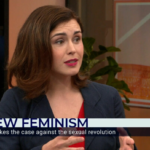Feminist Follies, or Why Men and Women are Different
The cultural revolution of the 60s unleashed a lot of madness and mischief on to the world. I should know, because I was a part of it. But I have obviously made a major turnaround since then.
I guess some of us meant well, but much of the agenda that we pushed has led to widespread misery and harm. Another former Sixties radical, David Horowitz, has chronicled such harm in his 1989 volume, Destructive Generation.
I too have written about the promises and perils of this calamitous period. But here I wish to focus on just one aspect, namely the attempt by radical feminists and the homosexual lobby to try to convince us that there are, or should be, no gender differences.
A silly androgyny was foisted upon us by the 60s’ radicals, in an attempt to deny any real differences between the sexes. Indeed, other extremes were promoted, such as the notion that there are not just two genders, but many. People, we were told, could be heterosexual today, transsexual tomorrow, bisexual the next, and so on.
There might be nine or ten different genders, said the radicals. Moreover, gender was a social construct, not a biological reality. Society imposes upon us false and stifling gender roles, when we should be free to explore many genders, and move in and out of them at will.
Of course radical social theory must always come up against the hard face of reality. Early on, scientists and experts began stating the obvious: men and women are different, and these differences are fundamental to who we are. Thus such books as Brain Sex by Anne Moir and David Jessel (1992) and Sex on the Brain by Deborah Blum (1998) appeared to show what science knows but the radicals do not: men and women are different, and we are hard-wired by nature to be so.
Differences in the brain is one area where we know clearly that men and women are not identical. Numerous other books and studies have also demonstrated this. A brand new book promoting the same idea is Louann Brizendine’s The Female Brain (2006).
Because I do not yet possess this important volume, and a good review of it appears in today’s Australian (September 27, 2006), I draw upon that. Janet Albrechtsen argues in “Feminism begs to differ, but unisex brain is a fantasy” that the fems have got it all wrong here. And Brizendine, an American neuro-psychiatrist, tells us why.
Begins Albrechtsen, “Only a girl could write The Female Brain and walk away with life and reputation intact. This new book may be contentious, but in fact modern science is merely playing catch-up with what we know intuitively. Girls are different from boys.”
Common sense tells us this. Anyone married a few weeks knows it well. Rocket science is not needed here. But the radical social engineers have been working overtime to make the silly look sensible. Thus it has become the accepted wisdom that men and women must be the same. But as Albrechtsen reminds us, “the unisex brain is a feminist fabrication”.
She offers this snap quiz: “Which sex uses, on average, about 20,000 words a day, in contrast to the 7000 uttered by the other sex? Who has two-and-a-half times the amount of brain space devoted to sexual drive, meaning they think about sex, on average, every 52 seconds? When their feelings are hurt by someone they love, which sex reacts by assuming the relationship is over? Who has larger sections of the brain for action and aggression? If you answered, in order, women, men, women, men, you’ve been watching too many Woody Allen movies. Now, science is confirming that Woody was right all along.”
Of course we are not completely different. But the differences that exist are substantial indeed: “While more than 99 per cent of male and female genetic coding is the same, it’s the less than 1 per cent of difference that packs a punch in marking out women from men. Drawing upon advances in gene technology and brain-imaging techniques that have revolutionised neuro-scientific research, Brizendine presents a heady cocktail of structural, chemical, genetic, hormonal and functional differences between women and men.”
Albrechtsen lists a number of these findings as presented by Brizendine. Consider just one: “Equality feminists will be even more disturbed by science that confirms what most of us already know: women are more emotional than men. Cutting to the chase, that means girls are more prone to over-reaction than boys. Were we to map the female brain, Brizendine says the connecting routes for emotion look more like super-highways, compared with the country roads you’d find inside the male brain. In a Stanford University study, when volunteers were shown emotional images while having their brains scanned, nine different areas lit up in women. In men, two areas lit up.”
But hard science always has a tough time competing with radical ideology. Much of academia is swamped with this feminist mumbo-jumbo. If anyone dares critique the reigning paradigm, he or she is quickly shouted down. This happened recently at Harvard University when its President Lawrence Summers gave a talk and mentioned his daughter.
He “told an academic conference that his young daughter, when given two trucks in another effort of gender-neutral parenting, treated them like dolls, calling one ‘daddy truck’ and the other ‘baby truck’. Some in the audience reacted with disgust to Summers’s address. A biologist from the Massachusetts Institute of Technology walked out, later saying leaving was the only option, otherwise ‘I would’ve either blacked out or thrown up’. Another quick test: was the tetchy academic a woman or a man?”
The science is there. But it has to compete with entrenched ideology. It is a tough ask. “Talking about genetic differences between men and women has long been taboo because, according to feminist orthodoxy, if women were different it necessarily meant they were inferior. But that competition-between-the-sexes business is so old hat these days.”
She continues, “Ignoring the differences, and framing public policy on a pretence that women are something they are not only ends up hurting women. For instance, in the heady days of 1970s feminism, it was assumed that universal child care would free women to achieve true equality with men. We now know that many women would prefer not to outsource the raising of their children. And so we need public policy and workplace changes that recognise that biological drive.”
Concludes Albrechtsen, “One reviewer suggests the book is ‘destined to become a classic in the field of gender studies’. If Harvard is anything to go by, that will have to happen outside the blinkered world of academe.”
Quite right. Getting modern universities to actually pursue free inquiry is a big ask. As I have written elsewhere, much of Western university life is about propaganda and indoctrination, not genuine learning. As one commentator put it, real and unfettered learning is “the difference between a university and a madrassa”.
The fems have long had their way in our universities. But hopefully thinkers like Brizendine and others will eventually help break this stranglehold over much of Western intellectual life. And it won’t be a moment too soon if and when it happens.
http://www.theaustralian.news.com.au/story/0,20867,20481754-32522,00.html
[1202 words]




















Bill,
Many thanks for this article. Your comment, “Real and unfettered learning is the difference between a university and a madrassa” is another of your pearls.
Some years ago a lecturer was asked at a Galatians group seminar, “How come a right winger like you got a job in a university?” His short answer was that the interviewing professer told him that his family name was the same as Trotsky’s. He replied, “He was my great uncle.” Much to the professor’s dismay he found he had employed a right winger.
Stan Fishley, Melbourne
I’d like to take this opportunity to once again promote Danielle Crittenden’s excellent “What Our Mothers Didn’t Tell Us: Why Happiness Eludes the Modern Woman.” Crittenden, with brilliant perspicacity, analyses the follies of feminism, discussing the baneful consequences they have had on all too many modern women. Crittenden is one of the most astute social observers out there.
Francis Gamba, Melbourne
Autopsy results in a Dutch study in 1995 indicated basic differences in the BSTc layer of the Hypothalamus between Males and Females. This was confirmed in later studies, which also showed differences at the cellular level.
No difference was detected between Gay and Straight people.
Dynamic MRI scans have since shown that the Human Brain is far more Gender Dimorphic than we’d thought.
This has not pleased the Radical Feminists. Unfortunately, the studies showed that people with Gender Dysmorphia (Transsexualism) had misgendered brains – which hasn’t pleased the Radical Right either.
Zoe Brain, Canberra